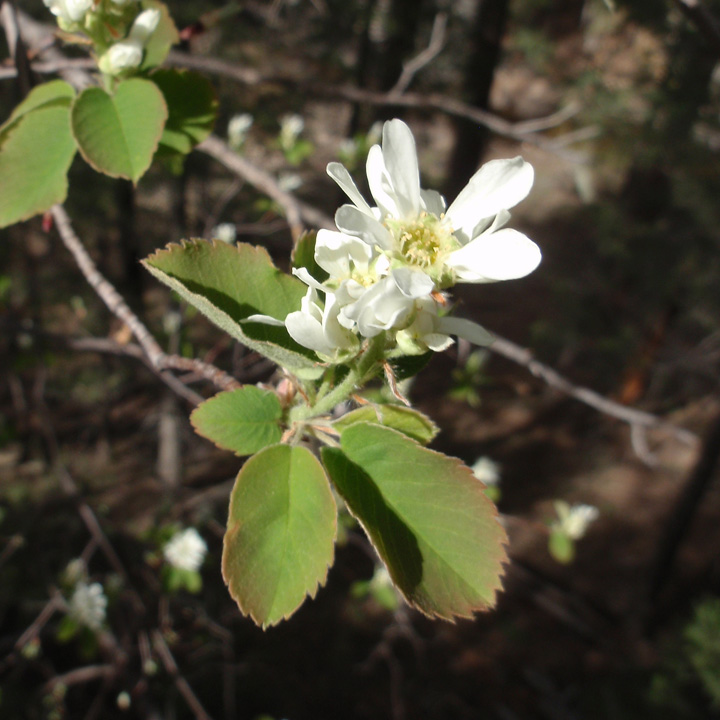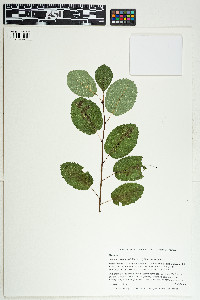- Home
- Search
- Images
- Datasets
- Sample Use
- How to Cite
- Additional Information
- About NEON
- NEON Data Portal
- ASU Biocollections
- About Symbiota
|
|
|
|
Family: Rosaceae
Saskatoon serviceberry
|
Clustered shrub or small tree mostly 2-5 m; lvs soon glabrous or nearly so, broadly elliptic to quadrate-rotund, to 6 cm, mostly 1-1.5 times as long as wide, coarsely toothed and strongly veined as in no. 3 [Amelanchier sanguinea (Pursh) DC.], often toothed only distally or across the broadly rounded or subtruncate summit; fls in short racemes, these mostly less than 2.5 cm in fl, to 3.5 cm in fr; pedicels relatively short, the lowest mostly 5-10 mm at anthesis; sep spreading to recurved, 1.5-3.5 mm; pet mostly 10-20 mm; ovary tomentose at the summit; fr subglobose, ca 1 cm, dark purplish, sweet and tasty. Thickets, borders of woods, and banks of streams; widespread in the w. cordillera and n. Great Plains, reaching our range in w. Minn. and nw. Io., and reputedly with outlying stations in Ont. and even w. Que. May. Gleason, Henry A. & Cronquist, Arthur J. 1991. Manual of vascular plants of northeastern United States and adjacent Canada. lxxv + 910 pp. ©The New York Botanical Garden. All rights reserved. Used by permission. Common Name: Saskatoon serviceberry Duration: Perennial Nativity: Native Lifeform: Shrub General: Deciduous shrub or small tree, 1-5 m (3-16 ft) tall; twigs reddish brown, hairy, becoming glabrous. Bark smooth, reddish brown when young, turning gray with age. Leaves: Alternate, simple, oval, oblong, or suborbicular, mostly 2-6 cm long, 1.5-4.5 cm wide, green above, paler beneath, often with prominent veins, glabrous to hairy on one or both surfaces, margins serrate from the middle of the blade to the apex, base rounded, truncate, or somewhat cordate, apex rounded, sometimes with a shallow notch; stipules filiform, soon deciduous; petiole 0.7-1.8 cm long. Flowers: Inflorescence a short, erect raceme of 5-15 flowers, hairy to glabrous; hypanthium brownish within; sepals 5, mostly 1.8-4 mm long, becoming reflexed at time of flowering; petals 5, oblanceolate, 7-13 mm long, white to pinkish; styles 4-5, stamens 20; fragrant; Fruits: Pome, round, 7-10 mm long, purplish to black purple, densely hairy at apex or sometimes glabrous, fleshy; seeds usually 10, 3.5-5 mm long, dark brown. Ecology: Streamsides, moist meadows, slopes, pi-on-juniper woodlands, ponderosa pine forests from 4,500-9,000 ft (1372-2743 m), flowers May- June. Distribution: Apache, Coconino, Gila, Navajo, and Yavapai counties; Canada, mid to western U.S. Notes: Amelanchier utahensis is similar to A. alnifolia, but it has smaller leaves and flowers, with 3-6 flowers in a raceme. Wild ungulates browse the twigs and foliage or A. alnifolia and many species of birds and mammals consume the fruits and bark. Reproduction occurs mainly from sprouting from the root crown or rhizomes, particularly following fire. Saskatoon serviceberry is intolerant of heavy shade, so it tends to eventually disappear from the forest unless fire or tree thinning occurs. Ethnobotany: Fruits can be eaten raw or made into jams. Editor: Springer et al. 2011 |



